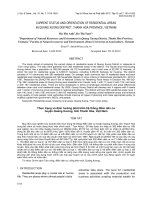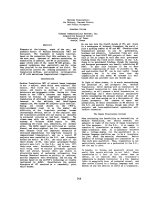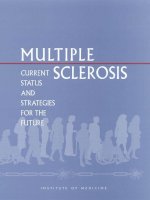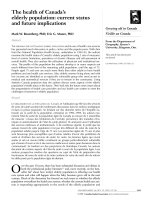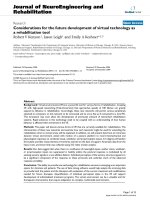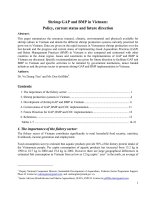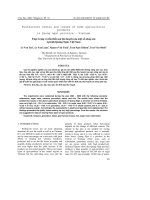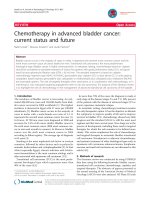Current status and future trends of nanoscale technology and its impact on modern computing, biology, medicine and agricultural biotechnology (2)
Bạn đang xem bản rút gọn của tài liệu. Xem và tải ngay bản đầy đủ của tài liệu tại đây (1.92 MB, 10 trang )
Current status and future trends of nanoscale technology and its impact on modern computing,
biology, medicine and agricultural biotechnology
D. Dutta Majumder, Christian Ulrichs, Debosmita Majumder, Inga Mewis, Ashoke Ranjan Thakur, R.
L. Brahmachary, Rajat Banerjee, Ayesha Rahman, Nitai Debnath, Dipankar Seth, Sumistha Das,
Indrani Roy, Amrita Ghosh, Prity Sagar, Carsten Schulz, Nguyen Quang Linh and Arunava Goswami
Abstract- Nanoscale technologies have gone from being
just an ambitious concept to being a rapidly advancing
area of interdisciplinary science with immense
practical importance. Feynman’s vision on nanoscience
provided great impetus to the development of
nanophysics, nanochemistry, nanoelectronics and
nanotechnology in general [1]. High resolution
microscopic devices such as scanning tunneling
microscope, transmission electron
D. Dutta Majumder is with ECSU, Indian Statistical Institute,
India. E-mail: / /
D. Dutta Majumder, Debosmita
Majumder, Nitai Debnath, Prity Sagar and Amrita Ghosh are
with the Institute of Cybernetics System and Information
Technology (ICSIT), Kolkata, 155, Ashoke Garh, Kolkata, Pin700108, India. Christian Ulrichs and Inga Mewis are with
Humboldt-Universität
zu
Berlin,
Institute
für
Gartenbauwissenschaften, Fachgebiet Urbaner Gartenbau,
Lentzeallee
55,
14195
Berlin,
Germany.
E-mail:
[C.
U.]
/
[I. M.]. Ashoke Ranjan Thakur and
Indrani Roy are with West Bengal University of Technology,
BF-142, Sector-I, Bidhannagar, Kolkata 700 064, West Bengal,
India. Email: [A. R. T.] /
[I. R.]. R. L. Brahmachary is a retired professor of biology,
Indian Statistical Institute (ISI) and presently works with Dr.
Arunava Goswami of ISI as guest researcher. Rajat Banerjee is
with Glass Science Section, Central Glass & Ceramic Research
Institute, Jadavpur, Kolkata-700 032, India. E-mail:
/
Carsten Schulz is with Humboldt University Berlin, Faculty of
Agriculture and Horticulture, Philippstr. 13, Haus 9, 10115
Berlin, Germany. Nguyen Quang Linh is with Hue University of
Agriculture and Forestry, 24 Phung Hung Str., Hue City,
Vietnam. Dipankar Seth, Ayesha Rahman and Sumistha Das
were 2006 short term visiting students in the laboratory of Dr.
Arunava Goswami at ISI. Arunava Goswami is with Biological
Sciences Division, ISI, 203 B. Road, Kolkata 700 108, West
Bengal,/Arunava_Goswami@brow
n.edu..
microscope and atomic force microscope etc. in mid1980s allowed researchers to see individual atoms on
surfaces and arrange them at will [2, 3]. The authors
(nanobiologists, computer scientists, biotechnologists
and material scientists) will attempt to provide a review
of the state of the art in the field of nanoscale
technologies and its impact on various fields of
research like computation, basic biology, medicine and
agricultural biotechnology. Imprints of memory
mechanisms [3] in living systems operating at different
levels (e.g. biochemical, immunological and neuronal)
has provided inputs to design and fabricate `bioinspired’ nanoelectronic devices suitable for various
applications. Several examples of such nanoscale
technology based frameworks and devices will be
presented in the scenario of their potential role in the
development of future nanoscale technologies.
Nanoscale technologies might finally revolutionize
computational intelligence and thinking. The power
and limits of computing processes govern the
intelligence, knowledge acquisition and thinking
process of human and machine. Present computational
methods and models provide us courage to study the
problem, but these tools are not yet sufficient to answer
the following riddles of machine intelligence- What can
computers do better than humans? What can humans
do better than computers? And the most important
one- what is computable? The authors will try to
present evidences that will show bio-inspired nanoscale
technologies might gain the power in helping us to go
deeper into these challenges of research in future.
Index
TermsAgriculture,
Alzheimer’s
disease,
biotechnology, cancer, computational biology, consciousness,
cybernetics, genomics, HIV, hydrophobic nanosilica, lipophilic
nanosilica, machine learning, malaria, metabolomics,
Nanoscience, nanosilica, neuronal network, pervasive
computing, quantum mechanics, reversible computing.
I. NanoComputer Systems Engineering (NCSE)
NCSE is an interdisciplinary study of the engineering
analysis and optimization of complex, highperformance computer systems composed of nanoscale
components. Using these methods, it has been projected
that by mid-century if not earlier, future generations of
nanocomputers using reversible computing will be
thousands of times more cost-effective.
Proceedings of the International Conference on Computing: Theory and Applications (ICCTA'07)
0-7695-2770-1/07 $20.00 © 2007
II. Thermodynamics of information erasure and
the concept of reversible computing
In a thermodynamically reversible chain, individual
nanoscale logical devices that are performing
computational operations in a nanocomputer is
expected to constitute a system with zero entropy [4].
The reversible version of the logical AND operation
B=A·C is called a Toffoli gate (it was first described
by Tomasso Toffoli then at MIT, now at Boston
University) and it has been implemented successfully
in quantum computing setups [5]. Using this
technology is considered to be the only way to
increase the information storage capacity for a
system, which we do not do much today. Keeping
such a system cool, however, will require reversible
computing [6].
III.
Moore's Law and Nanocomputing
The smallest features on today's commercially
available, state-of-the-art integrated circuits have
linear dimensions of about 350 nanometers (0.35
microns). Intel reports research on 250 nm, 180 nm
and 130 nm chips for continuing on the Moore's Law
curve for next 20 years [7]. It is hoped that
nanometer-scale replacements will allow vast
increases in memory density, power, and
performance. At least four distinct types of nanometer
scale computational mechanisms have been proposed:
mechanical, chemical, quantum and electronic [8].
IV. CNN visual computer with bio-inspired nanosensor technology
The CNN (cellular neural / nonlinear network)
paradigm developed in early 1990s resembles closely
to the functional vertebrate retina [9]. Retina inspired
CNN platforms has enabled us to make highly
efficient image processing platform for many
applications [10]. CNN visual microprocessor
operates at a rate of trillion operations per second [11,
12]. However recent results from neurophysiological
studies show clearly that due to limits of
microelectronics we are far from mimicking the
feature extraction, motion, visual blinking and color
vision performance capability of the human eye.
Therefore, in order to mimic human retina, sensory
systems should be equipped with following- (1)
sensors must be small enough without increasing real
estate, (2) sensitive in the VIS and IR region, (3) fast
enough to perform real time temporal analysis, (4)
with spectral purity for sensor fusion function, (5)
dynamic control with nanotechnology aided novel
sensor fusion and gain control demonstrating
synergies emerging from the convergence of
nanotechnology, biotechnology, and information and
cognitive science [11, 12]. Mechanical computers
would use tiny moving components called nanogears
to encode information. Such a machine is reminiscent
of Charles Babbage's analytical engines of the 19th
century [13]. For this reason, mechanical
nanocomputer technology has sparked controversy;
some researchers consider it unworkable. Prospects:
Quantum mechanics assures that molecular-scale
moving parts should not be subject to the large
frictional effects. Problems: How do you
manufacture it? How do you power it? How do you
program it?
In early 80’s one of the present author in his book
“Digital Computers: Memory Technology” authored a
detailed chapter on “Limitation of Existing Memory
Technology” and provided a technical review of the
then state-of-the-art continuous discrete and
semiconductor for memory systems along with
memory properties of the animals and came to the
conclusion the “Role of Chemical Codes” in
information processing must be considered both for
human and machine [14].
In 1994, Leonard Adleman took a giant step towards
a different kind of chemical or artificial biochemical
computer [15]. Prospects: Speed due to massively
parallel computation, energy efficiency, memory
capacity. Problems: Limited problem domain,
lacking efficient input and output techniques. A 100
nm feature size small-scale quantum mechanical
effects make the existing transistor designs useless
with shrinkage of depletion regions, tunneling, heat
dissipation and vanishing bulk properties and could
be overcomed by a number of nanometer-scale
replacements. Problems: How do you fabricate these
nanoelectronic computers? Possible techniques
Proceedings of the International Conference on Computing: Theory and Applications (ICCTA'07)
0-7695-2770-1/07 $20.00 © 2007
include: mechanosynthesis, chemosynthesis, chemical
self-assembly, lithography, and molecular beam
epitaxy (MBE). Will the machines execute
computations serially or in parallel? How will the
individual parts of a nanocomputer physically
communicate with one another (what type of
interconnects will be used)? How will error correction
be implemented? In addition, currently all these
quantum effect electronic devices only operate at
cryogenic temperatures [16]. Quantum computing
relies on quantum physics by taking advantage of
certain quantum physics properties of atoms or nuclei
that allow them to work together as quantum bits, or
qubits, to be the computer's processor and memory. A
quantum computer has the potential to be much more
powerful than a classical computer of the same size.
In using only a single processing unit, a quantum
computer can naturally perform myriad operations in
parallel [17].
V. Nanoscale technologies in Medicine
Usually a disease is composed of many biologically
different phenotypes and heterogeneity rampant
within individual cells of a single macroscopic
cancer. High surface areas of nanowires are suitable
as ultra-sensitive sensors in sub-50 nm range.
Combination of nanocomputing, functional genomics
and mathematical modeling might provide one of the
most powerful methods for diagnosing and
monitoring diseases.
Nanomaterials used in medicine could be classified
into four major types, viz. Carbon-based materials,
Metal-based materials, Dendrimers and Composites
[18]. Development and application of nano-structured
materials for medicine is expected to go through four
overlapping phases, viz. [a] First Generation [~20042010 (coded as passive nanostructure generation
phase)]: This stage is on the verge of completion. [b]
Second Generation [~2005 onwards (coded as active
nanostructure generation phase)]: High performance
nanocomposites, ceramics, metals etc. [c] Third
Generation (~2012 onwards): Novel robotics,
devices, 3D networks, biomimetic materials etc. [d]
Fourth generation (~2018 onwards): This generation
will specialize in molecule-by-molecule design and
self assembly capabilities, e.g. graphite film systems
[19]. Nano-electromechanical systems (NEMS) have
been found to be potentially much more compatible
with biology. In NEMS, the order of scale is 1-500
nm. These processes mimic nature’s ability to
produce such fantastic materials as pearls, coral,
calcite micro-lens and collagen. In case of quantum
dots, the fluorescence has been shown to be
permanent for the lifetime of the particle.
VI. Nanotechnologies in cancer research
The silicon dioxide coating has been functionalized
with an antibody, a tumor specific ligand, or a coating
to improve biocompatibility or targeting specificity.
In the first ever human NEMS controlled trial, iron
oxide nanoparticles have been used to identify
metastatic lymph nodes in patients with prostate
cancer. Colloidal gold, iron-oxide crystals, and
quantum dots (QDs) and semiconductor nanocrystals
having sizes 1–20 nm and have shown unique
diagnostic applications in malaria, HIV and cancer.
Nanoparticles have been used to monitor gene
expression or detect pathologies such as cancer, brain
inflammation, arthritis, or atherosclerotic plaques.
"Stealth" technologies with nanoparticles (20–150
nm) have been used to target solid tumors via
extravasation. FDA has already approved long
circulating liposomes with entrapped doxorubicin for
management/treatment of AIDS-related Kaposi’s
sarcoma, refractory ovarian cancer, and metastatic
breast cancer [20].
VII. Post-genomic era in biology and nanoscale
technologies in Agricultural Biotechnology
The path to achieve nutritional security for all is
complex. Two Indian world leaders in Economics and
Agriculture, Prof. Amartya K. Sen [21] and Dr. M. S.
Swaminathan, the father of the green revolution in
India [22] have researched extensively with their
expertise. There exists huge debate in the whole
world today that whether inside the genetically
modified (GM) crops plant metabolome has changed
due to introduction of foreign gene. This could be
answered by metabolomics studies and machine
learning. Throughout India, there is a major thrust
Proceedings of the International Conference on Computing: Theory and Applications (ICCTA'07)
0-7695-2770-1/07 $20.00 © 2007
now to find novel usage of plants. Identification of a
novel 14 KD isoform of peroxidase empowered us to
make a biotech kit, which is currently undergoing a
rigorous field trial in Ethiopia. This kit has been
welcomed by the Indian paper industry [23]. The
development
of
newer
and
sophisticated
nanoelectronics systems are needed for the following
specialties of the plants, viz. assays for many
metabolites with many different chemistries are
difficult. We present here results from the pioneering
experiments on surface modified nano-structured
silica developed by the scientists of the international
nano-silica network. Scientists working in this project
from the Indian Statistical Institute act as the nodal
agency for all the network programs in the Asian
countries.
This particular result has tremendous impact in
poultry industries in South East Asia in particular,
where mortality of young chickens due to malaria is
very high.
A
d
rbe
bso
ids
sa
Lip
get
of
ca
n
li
i
io
S
rp t
o
s
Ab
B
VIII. Nutritional security and Nanotechnology
We used coal fly ash, and then silica derived from the
cell walls of phytoplanktons, called `diatomaceous
earth’ (DE), as stored grain insect killers [Fig. 1]. We
have developed a variety of nano-structured particles
from the diatom cell silica, which kills insects
effectively. One of them is a unique formulation of
nanoparticles having hydrophobic and hydrophilic
properties. We has recently shown that these
lipophilic nano-particles also can reduce serum
triglycerides and VLDL in chickens artificially
infected with bird malarial parasite (Plasmodium
gallinaceum) [Fig. 7] [24-26] and thereby causing
significant reduction in the poultry chicken mortality.
Fig.2. Panel A: Hydrophobic and lipophilic surface modified
nanosilica can absorb cuticular lipid efficiently. Panel B:
Ultrastructural demonstration of cuticular lipid layer rupture by
FS 90.0s series nanosilica developed by us.
These nanostructured materials have been recently
found to be non-toxic to a variety of organisms like
human, fish, silkworm and Bracon hebetor (A.
Goswami, D. Seth, I. Roy, N. Debnath, A. Rahman,
R. L. Brahmachary, A. Das, A. Samanta and S. K.
Mukhopadhayay, unpublished data) [Fig. 7] [27].
Hybridization of the soft computing methods in the
design of the nanoparticles, nanosilica mediated gene
delivery in plants and pest control are bringing
revolution in the scientific world now.
electro statically applied
Fig.1. A number of different sources of natural silica were tested
by us for their insecticidal efficacy against a range of agricultural
insect pests. Few of them were found to be positive.
Pak-choi
(Brassica chinensis)
FOSSIL SHIELD® - DE based
Fig.3. Different field application techniques for modified
nanosilicas were developed with the help of scientists from
ZALF, BBA of Germany.
Proceedings of the International Conference on Computing: Theory and Applications (ICCTA'07)
0-7695-2770-1/07 $20.00 © 2007
photosynthesis [mmol CO2/m²*s], transpiration (mg/m²*s)
5
4
control
DE treated
DE washed of
AL06 treated
Transpiration
Photosynthese
compete with the cheapest pesticides available in the
Indian markets [28].
3
2
1
1
2
A
0
-1
-2
5.1.06
6.1.06
7.1.06
8.1.06
9.1.06
10.1.06
11.1.06
B
Fig.4. FS 90.0 s and AL-series nanosilicas do not alter the
incident plants’ photosynthesis and respiration rate. The larger
dataset from these studies will be analyzed by using machine
learning tools.
A
White flies in tomato production
D
C
B
Scale insects in indoor greenings
FossilShield 90.0s
reduced white fly population in controlled chamber experiments within 24 h to 60
%
Fig.5. Challenges ahead: The white flies in tomato could be
effectively controlled (panel A; 100% control within 24 hours;
30-90% humidity) by FS90.0s. But scale insects could not be
controlled by our present set of nanosilica as the scale insects
have different kinds of lipid constituents on the cuticle.
Coconut mite is causing havoc at present throughout
India. We expect these nanosilicas to exhibit excellent
efficacy against coconut mite as well. In studies on
plants, these nanosilicas did not show any adverse
effect on the plant physiology [Fig. 1-9], fish and
silkworm physiology [I. Roy, B. Weishaupt, C.
Ulrichs, I. Mewis and A. Goswami, unpublished data
(plant); A. Das, A. Samanta, N. Debnath, A. Rahman
and A. Goswami, unpublished data (silkworm); D.
Seth, S. K. Mukhopadhayay and A. Goswami,
unpublished data (fish)]. Our work resulted into a
number of patent applications of FossilShield Inc.,
which funded our work worldwide. To the best of our
knowledge, we are the pioneers worldwide on the use
of these surface modified nanoparticles in urban
horticultural settings [Fig.1-9]. Therefore study on the
mode of the action of these nanoparticles might
unravel yet unknown molecular processes. Further
modification of the nano-silica needs a large body of
soft computing based modeling studies using fuzzy
logic. Using these novel modeling methodologies will
lower the cost of production of these nanosilica to a
very low level and thereby the products could even
Fig. 6. Study of the insect tracheal and neuronal networks by
using FS90.0s and AL series nanosilica particles (Ch. Ulrichs, A.
Goswami and I. Mewis; © International nanosilica network).
Panel A (column 1): immunohistochemical mapping of the
tracheal connectivity network in control insects; Panel A
(column 2) shows the network connectivity after treating the
insects with FS90.0s and AL series nanosilica particles; Panel B
and C: immunohistochemcial mapping of insect sensory
apparatuses (panel B) and higher brain regions (panel C) after
treatment of surface modified nano-structured silica molecules;
panel D: Mapping of the higher brain region of the insect (as
shown in panel C) with fluorescent dye coupled to anti-HGL
antibodies after treating the insect with nanosilica.
A
B
C
D
Fig.7. Panel A: Splenic peroxidase in control chickens; Panel B:
Splenic peroxidase in chickens artificially infected bird malaria;
Panel C and D Splenic peroxidase in malaria infected chickens
treated with low dose (20 ppm) and high dose (200 ppm) of
surface modified FS90.0s nanosilica. [Dipankar Seth, Christian
Ulrichs, Inga Mewis and Arunava Goswami; © International
Nano-silica network]. The images were processed for semiquatitative measurements in vivo using NIH ImageJ, version
1.36 image processing software on Mac and PC platforms.
IX. Nanomaterials in modulation and altered
physiological development of neuronal networks
Spinal chord injury repair is the most challenging
areas of experimental biology and biotechnology [29].
Specialized carbon nanotubes (CNTs) made of novel
graphite were found to be well suited in the design
and fabrication of novel neural biomaterials [30].
Proceedings of the International Conference on Computing: Theory and Applications (ICCTA'07)
0-7695-2770-1/07 $20.00 © 2007
A
B
C
Pak-choi
(Brassica chinensis)
PA910®
- synthetic
Pak-choi
(Brassica
chinensis)
D
Pak-choi
(Brassica chinensis)
AL-06* - organic
E
F
Fig.8. Panel A: Insect treated with FS90.0s nanosilica (upper)
and the SEM picture of the nanosilica used to treat the insects
(inset in the panel D) for mapping of the neural and tracheal
network; Panel B: overview of the tracheal network in insect;
Panel C: insects treated with AL-series organic nanosilica
particles; Panel E and F: SEM of the PA910 synthetic
nanoaprticles and AL-06 organic nanoparticles respectively. ©
International nano-silica network and Fossilshield Inc.
1
2
A
B
C
D
Fig.9. Study of the insect tracheal and neuronal networks by
using FS90.0s and AL series nanosilica particles (Ch. Ulrichs, A.
Goswami and I. Mewis; © International nanosilica network).
Panel A (column 1): immunohistochemical mapping of the
tracheal connectivity network in control insects; Panel A
(column 2) shows the network connectivity after treating the
insects with FS90.0s and AL series nanosilica particles; Panel B
and C: immunohistochemcial mapping of insect sensory
apparatuses (panel B) and higher brain regions (panel C) after
treatment of surface modified nano-structured silica molecules;
panel D: Mapping of the higher brain region of the insect (as
shown in panel C) with fluorescent dye coupled to anti-HGL
antibodies after treating the insect with nanosilica.
Recently chemically modified multiwalled nanotubes
(MWNTs) were found to control neurite outgrowth in
vitro, by modulating interactions between neurons
and its extracellular matrices [31, 32]. Attempts are
currently underway in many laboratories towards
preparation of a glass substrate covered by “asproduced MWNT” or AP-MWNT. The major
challenges in this direction are as follows. (1) Poor
adherence of AP-MWNT to glass. This is necessary
during the neurite growth so that most of the neurites
could be kept floating around. (2) The use of a glass
substrate covered with AP-MWNT experiments
should be reproducible in terms of neurite growth rate
and elongation kinetics. (3) AP-MWNTs should be
devoid of impurities, such as amorphous carbon and
especially metallic nanoparticles, which, apparently,
help neither neurite growth nor elongation.
Functionalized MWNTs (f-MWNT) could be
dissolved in dimethylformamide (DMF) and these
MWNTs could then be used as successful
nanomaterials for neural therapeutics. Neural circuits
usually are capable of generating spontaneous
electrical activity. These spontaneous activities
depend on the electrophysiological properties of their
constituent neurons and connections, which could be
measured by single-neuron patch-clamp recordings
[33, 34]. Researchers have recorded spontaneous
postsynaptic currents (PSCs) from hippocampal
neurons plated directly on peptide-free borosilicate
glass coverslips (n = 15 cultures) as measured by
inward rectified currents of fluctuating amplitude
with a frequency of 1.1 ± 0.2 Hz. The result shows
that CNTs could be effectively used in the paradigm
for neural network systems. The efficiency of neural
signal transmission could be modulated by specific
inherent properties of CNTs materials, such as using
nanomaterials with high electrical conductivity. This
will be possible as transmembrane voltage could
modify voltage-dependent membrane processes.
Nanotube could also be used as a pathway which
allows direct electrotonic current transfer in the neural
networks, which ultimately affects redistribution of
charge along the surface of the membrane [35].
X. Nanoscale technology based platforms for
Alzheimer’s Dementia
Proceedings of the International Conference on Computing: Theory and Applications (ICCTA'07)
0-7695-2770-1/07 $20.00 © 2007
Alzheimer’s disease causes dementia in aged people
and affects millions of people worldwide [36-38].
Brain pathology in patients suggests that a sensitive
method to detect ADDLs in body fluid could provide
a viable clinical laboratory diagnosis platform for
Alzheimer’s disease. At present, no such laboratory
test exists [39]. LSPR nanosensor based spectroscopy
was used recently for demonstration of the sensitivity
of ADDL-functionalized nanoparticles to anti-ADDL
antibodies and will be revolutionizing this area of
clinical medicine in near future. Here, nanosphere
lithography (NSL) was used to create monodisperse,
surface-confined silver nanotriangles. Atomic force
microscope (AFM) images were collected using a
Digital Instruments Nanoscope IV microscope and
Nanoscope IIIa controller operating in tapping mode.
Resulting AFM linescan analysis reveals that the bare
nanoparticles are triangular, have ~90 nm
perpendicular bisectors, and are ~28-29 nm tall (0.4
nm Cr, 25 nm Ag, 2.5-3.5 nm increase in height due
to nanoparticle restructuring). This approach should
have important implications for understanding the
mechanism of Alzheimer’s disease and the loss of
memory mechanisms leading to the understanding of
the brain areas involved in memory storage and
retrieval [36-38].
XI. Consciousness and Quantum Physics:
Biotechnology of neural networks
Quantum mechanics has always been studied in
relation to consciousness. For years, quantum
mechanics has helped us to understand mechanism of
brain activity. For a long time, researchers were
curious to understand how migratory birds use their
retinal receptors not only for normal vision, but also
to 'visualize' longer distances by measuring the
direction and strength of the earth's geomagnetic
field. Quantum mechanics theories have been used to
describe two mechanisms for this `magnetoreception’
phenomenon. They are radical-pair mechanism and
magnetite-based mechanisms and these two operating
systems work in complementary fashion. In 2006,
researchers have shown evidences that radical-pair
mechanism provides directional information that is
comparable to that from a magnetic compass, whereas
the magnetite-based mechanism provides positional
information as it measures the strength of the signal,
which varies with location. Efforts are underway to
elucidate fully how the brain coordinates,
compensates for and processes information from the
two magnetic sources with normal vision. But the
major challenge of this century is to demonstrate the
robustness of such a seemingly classical phenomenon
within our higher brain activities like emotion,
cognition and consciousness [40]. The threshold of
complexity for consciousness could be traced back to
540 million years ago in small worms, such as
nematodes. Their neuronal network was sufficient to
create quantum tunnel effects involving 100–1,000
neurons, which scientists consider enough for
generation of a single conscious event. This single
event could have a pre-conscious time of 500
milliseconds. The basis for magneto-perception
described above might have evolved even earlier,
given that plants and animals have been shown to
suffer when shielded from the Earth's magnetic field.
If quantum mechanics is the basis of reality, then it
might be intimately involved in all kinds of biological
processes like sensation (olfaction, gustation etc.) and
cognition [41-44]. For example, nano-optics and
nano-photonics using on single quantum mechanical
phenomena has made tremendous progress in recent
years based on the ever improving understanding of
how to tune the properties of nanoparticles (i.e.
geometrical shape and material composition) and how
to manipulate the incident light in the right way to
achieve desired effects, such as extreme local-field
enhancement or controlling the flux of light at subwavelength dimensions. Simultaneously, emergence
of modern nano-fabrication techniques for material
processing on the nanometer scale, such as highresolution focused-ion-beam milling of novel and
more complex (prototype) material structures could
be used to prepare nano structured particles with
novel surface properties [27].
XII. Computational thinking
Computer scientists always have always drawn
inspiration from biological processes governing
memory, consciousness and also evolution through
patterned and non-patterned genetic variation. This is
essential to understand the limits and power of
Proceedings of the International Conference on Computing: Theory and Applications (ICCTA'07)
0-7695-2770-1/07 $20.00 © 2007
computing processes either by animals in real life or
machines. The major goal of cybernetics is therefore
to provide control and modulation of parameters for
the complex network processes like magnetoreception (early consciousness) described earlier. This
is indeed a complex problem. The realm of
computational thinking (CompuT) encompasses
following properties in general. CompuT (a) is a
fundamental skill of machine and man to read, write
and to do arithmetic, (b) involves problem solving,
designing systems and understanding human
behaviors like sensation (c) is thinking recursively
and therefore involves parallel processing. (d) uses
abstraction and decomposition when analyzing a
complex problem. Usually, computer science deals
with the study of computation, viz., what is
computable and how. Therefore, CompuT (1)
involves programming and conceptualizing (2)
includes both fundamental and mechanical routine of
the computation (3) it follows the way human thinks
and solves problems. (4) complements and combine
mathematical and engineering thinking beyond
physical world [45, 46].
XIII. Cybernetics and high end computational
biological approach for cancer treatment: A
system biology approach
In this direction, studies from one of the present
authors on mathematical modeling of auto-regression
and long term arrest of cancerous tumors lead to the
development of knowledge based medical diagnostics
against cancer earlier. Following specific theoretical
and experimental research is worth mentioning. (a)
Study of cancer auto-regression, self remission and
tumor instability using cybernetic analysis; (b)
application of cybernetic approach to medical
technology with knowledge based framework and
multi-modal medical image processing for diagnosis
and treatment planning using – CT, MR (T1), MR
(T2), SPECT, USG etc. for detection and grading of
malignancy / benignancy with oncological data. (c)
development of a novel feature selection and gene
clustering from gene expression data established on a
real life molecular cancer dataset. (e) study of
evolution of cancer and its mathematical modeling.
Our future plan include development of (1) advanced
level `Multimodal Medical Image Processing
Research’ towards development of more efficient
diagnostics and therapeutic regimens for early
detection of cancer and subsequent management
principles in different paradigms. (2) theoretical study
using `Fuzzy Dynamical approach’ for modeling of
complex systems with data of various types of
malignancy, to study the progression and regression
of malignancy from the perspective of `NonEquilibrium
Computational
Dynamics
and
Thermodynamic Stability’ theory and correlation with
the clinical results. (3) study of the fitness of the
computational mathematical models on the drug
induced progression and regression of tumors. (4)
generation of early screening methods for high risk
cancer patient groups (5) development of plant,
animal derived molecule based therapy and immunotherapeutics for regression of cancer cells in vitro and
in vivo with the help of scientists from international
nanosilica network. [47-59].
XIV. Conclusion
In this article we have cited numerous examples from
computation, basic biology, medicine and agricultural
biotechnology showing that nanoscale technologies
based framework, platforms, devices and reagents are
being used by interdisciplinary researchers for
understanding complex insect and human behaviors
and perceptions respectively (e.g. consciousness and
lethality) [27]. In the field of agricultural
biotechnology, pioneering development of surface
modified lipophilic nanosilica by the researchers of
`international nanosilica network’ have been
welcomed by Indian as well as international business
communities resulting into world patents’ application
by EU industrial partners of the network. It is
worthwhile to mention here that machine learning has
transformed statistics in recent times. Statistical
learning is now widely used for studying problems on
a scale (both in terms of data size and dimensions),
unimaginable even a decade ago. Let us close with
the expectation with which we started this paper.
Computer scientists’ interest in biology is driven by
their belief that biological processes could be used as
template to study difficult problems in computing like
computational thinking. Computational thinking has
Proceedings of the International Conference on Computing: Theory and Applications (ICCTA'07)
0-7695-2770-1/07 $20.00 © 2007
influenced heavily other scientific disciplines and
vice versa. On the other hand, computer scientists’
contribution to biology would go much further way
than the pattern recognition in large sequence
databases. Advent of modern methods of nano
computing method based controlled synthesis of
nano-assemblies and nano-platforms will allow us to
decipher codes for higher order brain behaviors and
high level computation forming an effective bridge
between much sought after man-machine interface.
REFERENCES
[1] R. Feynman, “There's plenty of room at the bottom,” Science, vol.
254, pp. 1300-1301, 1991.
[2] D. Dutta Majumder, R. Banerjee, Ch. Ulrichs, I. Mewis, A.
Samanta, A. Das, S. K. Mukhopadhayay, S. Adhikary and A. Goswami,
“Nano-fabricated Materials in Cancer Treatment and Agri-biotech
Applications: Buckyballs in Quantum Holy Grails,” IETE Journal of
Research, Special Issue on Nanoscience, September- October 2006 (In
Press).
[3] D. Dutta Majumder and J. Das, “Limitations of exisiting memory
technologies and prospects for biochemical memories,” In Digital
computers memory technology, Second Edition, John Wiley and Sons,
1983.
[4] Frank P Michael., “Reversibility for Efficient Computing,” Ph.D.
dissertation, MIT, Dept. of Electrical Eng. & Computer Science, 1999.
[5] Edward Fredkin, and Toffoli Tommaso, “Design principles for
achieving high performance submicron digital technologies," proposal
to DARPA, MIT Lab. for Comp. Sci., 1978. unpublished but widely
circulated and seminal.
[6] A. De Vos, "Reversible and Endoreversible Computing", Int.
Journal of Theor. Phys., Vol. 34, 1995, pp. 2251-2266.
[7]Intel
Report,
/>[8] Michael S. Montemerlo, J. Christopher Love, Gregory J. Opiteck,
David Goldhaber-Gordon and James C. Ellenbogen
of
MITRE
Nanosystems Group Inc., 2005.
[9] L. O. Chua and T. Roska, The CNN paradigm, IEEE transactions on
circuits and systems, vol. 40, pp. 147-156, 1993. [10] F. S. Werblin, B.
Roska, and D. Balya, Parallel processing in the mammalian retina:
lateral and vertical interactions across stacked representations, Progress
in Brain Research, vol. 131, pp. 229-238, 2001.
[11] T. Roska and A. Rodriguez-Vazquez, Towards visual
microprocessors, Chichester, England: John Wiley, 2001.
[12] G. Linen, R. Dominguez-Castro, S. Espejo and A. RodriguezVazquez, ACE-16k: a programmable focal plane vision processor with
128 X 128 resolution, Proceedings of the 15th European conference on
Circuit Theory and Design (ECCTD ’01), Helsinki, Finland, vol. 1, pp.
600-608, 2001.
[13] Charles Babbage, (1792-1871), “Dictionary of Natural Biography
II” (London 1885), pp. 304.
[14] D. Dutta Majumdar and J. Das, “Digital Computers Memory
Technology” Wiley Eastern, 1980.
[15] L. Adleman, "Molecular Computation of Solutions to
Combinatorial Problems," Science, vol. 266, pp. 1021-1023, 1994.
[16] Stenger David and James Hickman, NRL-SAIC Prototype
Bioelectronic Computer, Nanotechnology, 2020.
[17] />
[18] L. Balogh, A. Bielinska, J. D. Eichman, R. Valluzzi, I. Lee, J. R.
Baker Jr., T. S. Lawrence and M. K. Khan, “Dendrimer nanocomposites
in medicine,” Chimica OGG/Chemistry Today, vol. 5, pp. 85-40, 2002.
[19] G. M. Whitesides and L. J. Christopher, “The art of building
small,” Scientific American, vol. 285, no. 3, pp. 38-47, 2001.
[20] J. R. Baker Jr., A. Quintana, L. Piehler, M. Banaszak-Holl, D.
Tomalia and E. Raczka, “The Synthesis and Testing of Anti-Cancer
Therapeutic Nanodevices,” Biomedical Microdevices, vol. 3, no. 1, pp.
59-67, 2001.
[21] A. K. Sen, “Beyond the Crisis: Development Strategies in Asia
(From Sustainable Development and Human Security—Second
Intellectual Dialogue on Building Asia's Tomorrow,” Tokyo: Japan
Center for International Exchange, 1999 [And the references therein].
[22] M. S. Swaminathan, “Science in response to basic human needs,”
Current Science, vol. 77, no. 3, pp. 341-353, 1999 [and the references
therein].
[23] F. Das, M. K. Sinha, A. Chatterjee, K. Chakrabarty, S. K. Pal and
A. Goswami, “Antibody mediated kit development of jute and other
plant peroxidases at the field level,” In proceedings of the International
Seminar on Frontiers of Basic and Molecular Biology [eds. Prof.
Chanchal Dasgupta (FNA, India) et al.], pp. 115-118, 2005.
[24] A. Goswami, S. Singh, V. D. Redkar, S. Sharma, “Characterization
of P0, a ribosomal phosphoprotein of Plasmodium falciparum.
Antibody against amino-terminal domain inhibits parasite growth,”
Journal of Biological Chemistry, (American Society for Biochemistry
and Molecular Biology), vol. 272, no. 18, pp 12138-12143, 1997.
[25] S. Sharma, A. Goswami, N. J. Singh, L. Kabilan and S. S.
Deodhar, “Immunogenicity of the nonrepetitive regions of the
circumsporozoite protein of Plasmodium knowlesi,” American Journal
of Tropical Medicine and Hygiene, vol. 55, no. 6, pp. 635-41, 1996.
[26] S. Singh, A. Sehgal, A. Goswami, S. Waghmare, T. Chakrabarty
and S. Sharma, Surface expression of the conserved ribosomal protein
P0 on parasite and other cells, Molecular and Biochemical Parasitology
(Elsevier), vol. 119, no 1, pp 121-124, 2002.
[27] D. Dutta Majumder, R. Banerjee, Ch. Ulrichs, I. Mewis, A.
Samanta, A. Das, S. K. Mukhopadhayay, S. Adhikary and A. Goswami,
“Nano-fabricated Materials in Cancer Treatment and Agri-biotech
Applications: Buckyballs in Quantum Holy Grails,” IETE Journal of
Research, Special Issue on Nanoscience, September- October 2006 (In
Press).
[28] Christian Ulrichs, Inga Mewis and Arunava Goswami, “Crop
Diversification Aiming Nutritional Security in West Bengal Biotechnology of stinging capsules in nature’s water-blooms,” Ann.
Tech. Issue of State Agri. Technologists Service Assoc. ISSN 0971975X, vol. 10, pp 1-18, 2006.
[29] M. S. Dresselhaus, G. Dresselhaus and Ph. Avouris, “Carbon
Nanotubes: Synthesis, Structure, Properties and Applications,”
Springer: Berlin, 2001.
[30] M. P. Mattson, R. C. Haddon and A. M. Rao, “Molecular
Functionalization of Carbon Nanotubes and Use as Substrates for
Neuronal Growth,” J. Mol. Neurosci., vol. 14, no. 3, pp. 175-182, 2000.
[31] H. Hu, Y. Ni, V. Montana, R. C. Haddon and V. Parpura,
“Chemically Functionalized Carbon Nanotubes as Substrates for
Neuronal Growth,” Nano Lett., vol. 4, no. 3, pp. 507-511, 2004.
[32] V. Georgakilas, K. Kordatos, M. Prato, D. K. Guldi, M. Holzinger
and A. Hirsch, “Organic Functionalization of Carbon Nanotubes,” J.
Am. Chem. Soc., vol. 124, no. 5, pp. 760-761, 2002.
[33] W. J. Parak, M. George, M. Kudera, H. E. Gaub and J. C.
Behrends, “Effects of semiconductor substrate and glia-free culture on
the development of voltage-dependent currents in rat striatal neurons,”
Eur. Biophys. J., vol. 29, no. 8, pp. 607-620, 2001.
[34] J. Brask, K. Kristensson and R. H. Hill, “Exposure to interferon-γ
during synaptogenesis increases inhibitory activity after a latent period
Proceedings of the International Conference on Computing: Theory and Applications (ICCTA'07)
0-7695-2770-1/07 $20.00 © 2007
in cultured rat hippocampal neurons,” Eur. J. Neurosci., vol. 19, no. 12,
pp. 3193-3201, 2004.
[35] E. J. Vigmond,; J. L. Perez Velazquez, T. A. Valiante, B. L.
Bardakjian and P. L. Carlen, “Mechanisms of Electrical Coupling
between Pyramidal Cells,” J. Neurophysiol., vol. 78, pp. 3107-3116,
1997.
[36] D. D. Majumder and M. Bhattacharya, “Registration and fusion of
CT, T(1) and T(2) weighted MR images of brain of Alzheimer’s
patients”, J. Com. Sci. Informatics, Computer Society of India, vol. 4,
no. 3-4, pp. 12-22, 1997.
[37] D. D. Majumder and M. Bhattacharya, “Registration of multimodal
images of Alzheimer patient: A shape theoretic approach,” Pattern
Recognition Letters, Elsevier Science, vol. 21, pp. 531-548, 2000.
[38] Facts About Alzheimer’s Disease (www.alz.org); Alzheimer ’s
disease and Related Disorders Association, Inc., 2004.
[39] T. Rindzevicius, Y. Alaverdyan, A. Dahlin, F. Hook, D. S.
Sutherland and M. Kall, “Plasmonic Sensing Characteristics of Single
Nanometric Holes,” Nano Lett., vol. 5, no. 11, pp. 2335-2339, 2005.
[40] R. Wiltschko and W. Wiltschko, “Magnetoreception,” Bioessays,
vol. 28, no. 2, pp. 157–168, 2006.
[41] P. Gall and A. Pazur, “Magnetoreception in plants,” J Plant Res.,
vol. 118, pp. 371–389, 2005.
[42] Ch. Ulrichs, A. Goswami and I. Mewis, (2007) “Nano-structured
silica – physical active pesticides for urban settings,” (Abstract accepted
for keynote presentation), 2nd International Symposium, Plant
Protection and Plant Health in Europe [Organized by the German
Phytomedical Society (DPG) and British Crop Production Council
(BCPC), Berlin, 10 - 12 May 2007.
[43] B. Hecht, “Nano-optics with single quantum systems,” Phil. Trans.
R. Soc. Lond. A, vol. 362, pp. 881–899, 2004.
[44] D. D. Majumder, “A unified view of pattern recognition, mage
analysis, computer vision and artificial intelligence,” Proc. NATO
advanced research workshop on Pyramidal systems for Image
processing and computer vision, (ed. Levialdi), Fienum press, MarateaNaples, Italy, May 1986.
[45] D. D. Majumder, “A unified approach to artificial intelligence,
pattern recognition, image processing and computer vision in fifth
generation computer system“, Int. J. Of Inf. Sci., vol. 45, pp. 391-431,
Elsevier Science, N. Y., 1988.
[46] D. D. Majumder, “Mind-body duality: its impact on pattern
recognition and computer vision research,” Third APRDT, ISI, P. C.
Mahalanobis birth centenary volume, pp. 3-17, December 1993.
[47] D. Dutta Majumder, P. Roy, R. Kozma and J. Biswas, “A
Cybernetic Approach to Spontaneous Cancer Remission: Exploring a
New Paradigm for Cancer Treatment,” In R Vallee & J Rose (ed),
Recent Advances in Cybernetic and Systems ICCS Series. World
Organization of Systems and Cybernetics, Paris, 1999.
[48] D. Dutta Majumder and P. Roy, “Cancer Self-remission And
Tumour Instability – A Cybernetic Analysis: Towards a Fresh Paradigm
for Cancer Treatment,” Kybernetes, vol. 29, nos. 7-8, (Frank George
Research Award Winning Paper II), pp. 896 – 925, 2000.
[49] P. K. Roy, D. Dutta Majumder and P. K. Sen, “Spontaneous
Cancer-Regression - Theory based on Thermodynamic Laws &
Stability Theory,” Fifth International Conference on Anticancer
Research : President's Symposium on Spontaneous Cancer Regression,
Organization of Comparative Oncology, Silver Spring, Maryland,
October, 1995.
[50] P. K. Roy, D. Dutta Majumder and P. K. Sen, “The Paradox of
Spontaneous Cancer Regression: Therapeutic Duplication and
Foundations of A Theory Using Thermodynamic Laws & Stability
Theory”, Anticancer Research, vol. 15, no. 5A, pp. 1792 – 1795, 1995.
[51] P. Roy, J. Biswas and D. Dutta Majumder, “Paradox of
Spontaneous Cancer Regression: Implications for Fluctuation
Radiotherapy and Radiothermy,” Indian Journal of Physics, vol. 73-B,
no. 5, pp. 777-793, 1999.
[52] P. Roy, J. Biswas, D. Dutta Majumder, K. Tomita, H. Tsuchiya and
H. Mohri, “Thermal Fever Induced Spontaneous Regression and
Prolonged Arrest of Tumour, Implications for a Radiotherapy,”
Proceedings of International Conference on Nuclear Data for Science
and Engineering, Paper log #573, International Centre for Theoretical
Physics/ International Atomic Energy Agency, Trieste, 1996.
[53] M. Bhattacharya and D. Dutta Majumder, “Breast Cancer
Screening Using Mammographic Image Analysis,” Sixteen
International CODATA Conference, New Delhi, 8-12 November 1998.
[54] M. Bhattacharya and D. Dutta Majumder, “Cancer Screening
Using Image Analysis,” Seminar on ‘Computers in Medical
Technology’ in collaboration with Birla Industrial Technological
Museum and Science Association of Bengal, Calcutta, 4-5 December,
1998.
[55] D. Dutta Majumder and M. Bhattacharya, “Cybernetic Approach to
Medical Technology: Application to Cancer Screening and Other
Diagnostics, Millennium Issue in the journal Kybernetes, U.K. (Frank
George Research Award Paper), vol. 29, no. 7-8, pp. 871 – 895, 2000.
[56] D. Dutta Majumder, “Multimodal Image Processing, Registration
& Fusion: Mathematical Tools and Application,” keynote paper,
International Conference on Advances in Pattern Recognition, ISI &
IAPR, 2003.
[57] P. Mitra and D. Dutta Majumder, “Feature Selection and Gene
Clustering from Gene Expression Data,” 17th IAPR, Cambridge
University, 2001.
[58] D. P. Mukherjee and D. Dutta Majumder, “Tongue Image Analysis
Software,” Intelligent Systems Design and Applications, series:
Advances in Soft Computing, Springer XVIII, pp 403-412, 2003.
[59] D. Dutta Majumder and M. Bhattacharya, “Cybernetic Approach to
Medical Technology for Diagnosis and Therapy Planning,” Proceedings
to Eleventh International Congress of Cybernetics and Systems, World
Organisation of Systems and Cybernetics, Brunel University, Uxbridge
Middlesex, West London, pp 103-109, August 1999.
Proceedings of the International Conference on Computing: Theory and Applications (ICCTA'07)
0-7695-2770-1/07 $20.00 © 2007
View publication stats
